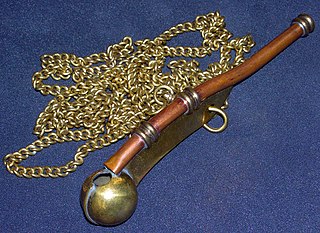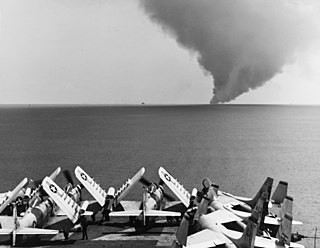
Maritime transport or more generally waterborne transport, is the transport of people (passengers) or goods (cargo) via waterways. Freight transport by sea has been widely used throughout recorded history. The advent of aviation has diminished the importance of sea travel for passengers, though it is still popular for short trips and pleasure cruises. Transport by water is cheaper than transport by air or ground, but significantly slower for longer distances. Maritime transport accounts for roughly 80% of international trade, according to UNCTAD in 2020.

USS Bonhomme Richard (LHD-6) was a Wasp-class amphibious assault ship of the United States Navy commissioned on 15 August 1998. Like the previous five Wasp-class ships, Bonhomme Richard was designed to embark, deploy, and land elements of a Marine Corps landing force in amphibious assault operations by helicopter, landing craft, and amphibious vehicle, and, if needed, to act as a light aircraft carrier.

A ship's bell is a bell on a ship that is used for the indication of time as well as other traditional functions. The bell itself is usually made of brass or bronze, and normally has the ship's name engraved or cast on it.

The United States Merchant Marine is an organization composed of United States civilian mariners and U.S. civilian and federally owned merchant vessels. Both the civilian mariners and the merchant vessels are managed by a combination of the government and private sectors, and engage in commerce or transportation of goods and services in and out of the navigable waters of the United States. The Merchant Marine primarily transports domestic and international cargo and passengers during peacetime, and operate and maintain deep-sea merchant ships, tugboats, towboats, ferries, dredges, excursion vessels, charter boats and other waterborne craft on the oceans, the Great Lakes, rivers, canals, harbors, and other waterways. In times of war, the Merchant Marine can be an auxiliary to the United States Navy, and can be called upon to deliver military personnel and materiel for the military.
A dog watch is a work shift, also known as a "watch", in a maritime watch system that is half the length of a standard watch period. This is typically formed by splitting a single four-hour watch period between 16:00 and 20:00 to form two two-hour dog watches, with the "first" dog watch from 16:00 to 18:00 and the "second" or "last" dog watch from 18:00 to 20:00.
This glossary of nautical terms is an alphabetical listing of terms and expressions connected with ships, shipping, seamanship and navigation on water. Some remain current, while many date from the 17th to 19th centuries. The word nautical derives from the Latin nauticus, from Greek nautikos, from nautēs: "sailor", from naus: "ship".

A boatswain's call, pipe, or bosun's whistle is a pipe or a non-diaphragm type whistle used on naval ships by a boatswain.
A second mate or second officer (2/O) is a licensed member of the deck department of a merchant ship holding a Second Mates Certificate of Competency, which is issued by the administration. The second mate is the third in command and a watchkeeping officer, customarily the ship's navigator. Other duties vary, but the second mate is often the medical officer and in charge of maintaining distress signaling equipment. On oil tankers, the second mate usually assists the chief mate with the cargo operations.

A third mate (3/M) or third officer is a licensed member of the deck department of a merchant ship. The third mate is a watchstander and customarily the ship's safety officer and fourth-in-command. The position is junior to a second mate. Other duties vary depending on the type of ship, its crewing, and other factors.

The deck department is an organisational team on board naval and merchant ships. The department and its manning requirements, including the responsibilities of each rank are regulated within the STCW Convention, applicable only to the merchant fleets of countries who have ratified it. The department is led by deck officers, who are licensed mariners, and they are commanded overall by the ship's captain. Seafarers in the deck department work a variety of jobs on a ship or vessel, but primarily they will carry out the navigation of a vessel from the bridge. However, they are usually also responsible for supervising and monitoring any maritime cargo on board, as well as ensuring maintenance of the deck and upper hull structure, monitoring the stability of the ship, including loading and discharging ballast water, carrying out mooring operations, and finally anchoring a ship.
Seafaring is a tradition that encompasses a variety of professions and ranks. Each of these roles carries unique responsibilities that are integral to the successful operation of a seafaring vessel. A ship's crew can generally be divided into four main categories: the deck department, the engineering department, the steward's department, and other. The reasoning behind this is that a ship's bridge, filled with sophisticated navigational equipment, requires skills differing from those used on deck operations – such as berthing, cargo and/or military devices – which in turn requires skills different from those used in a ship's engine room and propulsion, and so on.

USS Annapolis (AGMR-1) was the former USS Gilbert Islands and a Commencement Bay-class escort carrier of the United States Navy.
A command duty officer or officer of the watch is the head duty officer on a ship, entrusted by the commanding officer and executive officer or the shipmaster with exercising in their absence command and control of the ship on their behalf for the duration of a watch.

USS Fitzgerald (DDG-62), named for United States Navy officer Lieutenant William Charles Fitzgerald, is an Arleigh Burke-class destroyer in the US Navy.

On 29 July 1967, a fire broke out on board the aircraft carrier USS Forrestal after an electrical anomaly caused a Zuni rocket on an F-4B Phantom to fire, striking an external fuel tank of an A-4 Skyhawk. The flammable jet fuel spilled across the flight deck, ignited, and triggered a chain reaction of explosions that killed 134 sailors and injured 161. At the time, Forrestal was engaged in combat operations in the Gulf of Tonkin, during the Vietnam War. The ship survived, but with damage exceeding US$72 million, not including the damage to aircraft. Future United States Senator John McCain and future four-star admiral and U.S. Pacific Fleet Commander Ronald J. Zlatoper were among the survivors. Another on-board officer, Lieutenant Tom Treanore, later returned to the ship as its commander and retired an admiral.

The United States Navy occupational rating of boatswain's mate is a designation given by the Bureau of Naval Personnel (BUPERS) to enlisted members who were rated or "striking" for the rating as a deck seaman. The colloquial form of address for a boatswain's mate is "Boats".

A sailor, seaman, mariner, or seafarer is a person who works aboard a watercraft as part of its crew, and may work in any one of a number of different fields that are related to the operation and maintenance of a ship.

Early on 17 June 2017, the United States Navy destroyer USS Fitzgerald collided with MV ACX Crystal, a Philippine-flagged container ship, about 80 nautical miles southwest of Tokyo, Japan; 10 nautical miles southeast of the city of Shimoda on the Japanese mainland (Honshu).
This glossary of nautical terms is an alphabetical listing of terms and expressions connected with ships, shipping, seamanship and navigation on water. Some remain current, while many date from the 17th to 19th centuries. The word nautical derives from the Latin nauticus, from Greek nautikos, from nautēs: "sailor", from naus: "ship".
Nautical operations refers to the crew operation of a ship. It is the term used in academic education to refer to the studies of this professional field. Nautical operations refers to all the operational procedures, specific roles of officers and crew members, and regular functions and technical processes, which together shape the structure and functions for the general operations of a ship.













